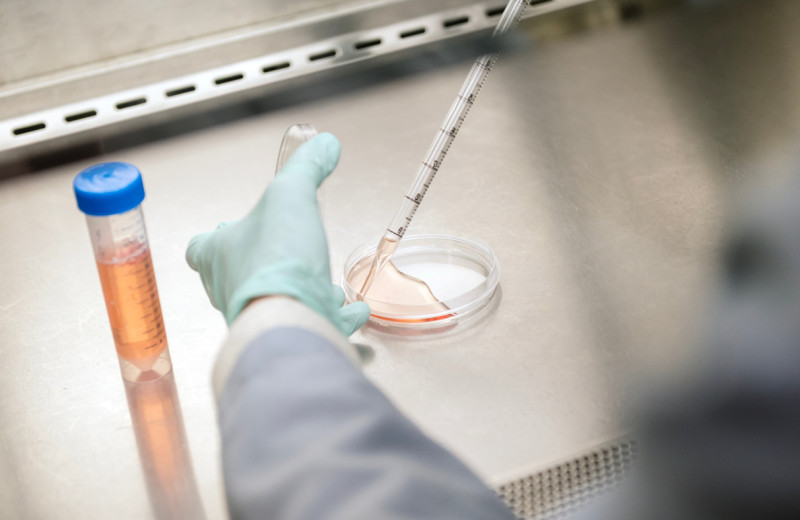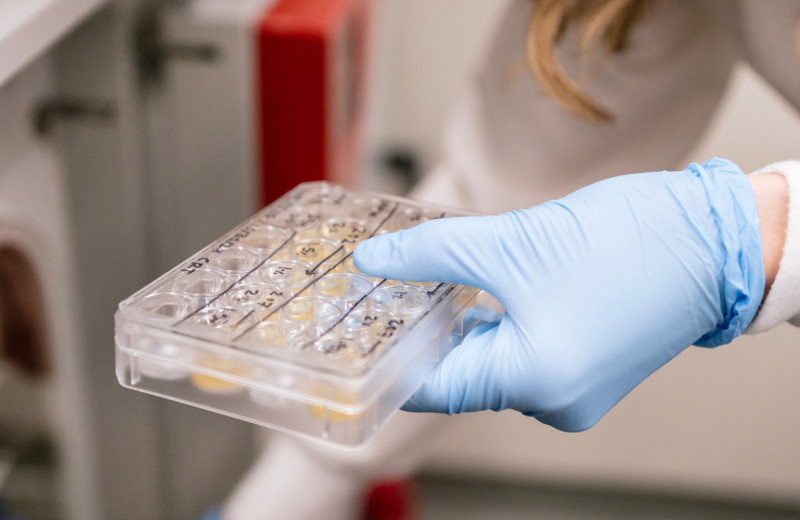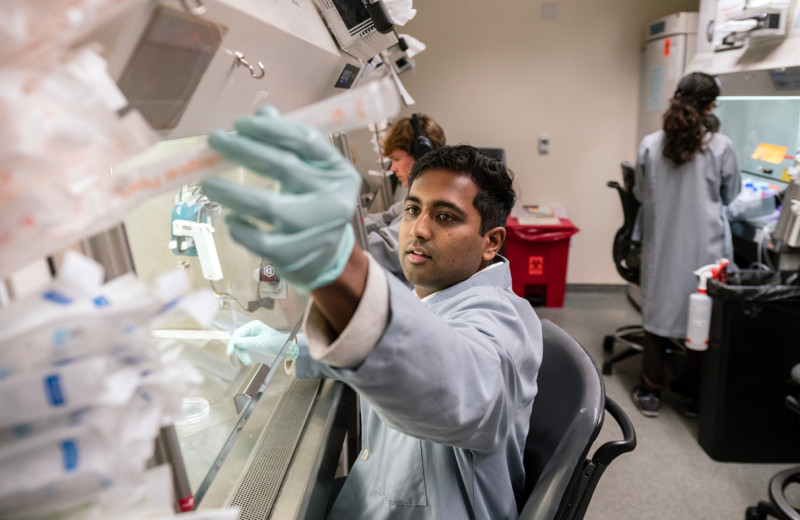Gladstone NOW: The Campaign Join Us on the Journey✕

As clinical trials in Alzheimer's disease have failed, Gladstone investigators are taking innovative approaches to understanding the disease and finding new therapeutic targets.
Slowly, she becomes a shell of what she once was. First, she misplaces keys, the dog’s leash, a plate of breakfast. Words and ideas vanish somewhere between their conception and the tip of the tongue. Then she puts her shoes away in the freezer, forgets to eat dinner, and begins to lose precious memory fragments—a trip, a friend’s face.
There’s no questioning what happens when a person develops Alzheimer’s disease; the story of memory loss, confusion, depression, and anxiety has been told and retold. But what is slowly—or not so slowly—unraveling inside an Alzheimer’s-ridden brain is less clear. As memories slip away, what’s to blame? Sticky bristles of amyloid that clump up between brain cells? Tangled strands of tau that make cellular highways collapse? Proteins that slip through a weakened blood-brain barrier and turn the body’s immune system on the brain? Or something undiscovered?
For years, scientists trying to dream up new drugs against Alzheimer’s focused on one of the starkest physical signs of disease that can be seen by microscopy, after death, in the brains of Alzheimer’s patients: amyloid plaques. These visible clumps of amyloid-beta protein lodged between neurons seemed an obvious culprit for causing disease. But each clinical trial aimed at shuttling away amyloid-beta or keeping it from accumulating has failed, casting doubt on the potential of these therapeutic strategies.
Today, most researchers don’t doubt that amyloid-beta plays a role, but they’re also focusing their attention on a handful of other prime suspects that might contribute to Alzheimer’s.
“This is a multi-causal disease that requires a multi-pronged plan of attack,” says Lennart Mucke, MD, the founding director of the Gladstone Institute of Neurological Disease.
For more than two decades, Mucke has been heading up the Alzheimer’s research program at Gladstone and purposefully assembling a diverse cast of scientists that can tackle the disease from nearly every imaginable angle. “Our ambition to understand Alzheimer’s at all levels of complexity, including brain networks, is a very unique feature of our program,” he says.
In Your Genes
Before the lost glasses, the bursts of anger, and the blank stares; when he can dress himself and carry on a conversation, his brain is already teeming with tiny changes. If he’s one of around three-quarters of all Alzheimer’s patients, he has a gene called ApoE4 that makes him prone to the disease. ApoE4 drastically increases the risk of developing the disease and also accelerates the onset of symptoms.
Everyone has one version or another of the ApoE gene; it comes in three isoforms, ApoE2, ApoE3, and ApoE4. At Gladstone, researchers have built a case that ApoE4 is more than just a risk factor for Alzheimer’s; it directly contributes to the impairment of brain cells.
“I don’t believe there’s any such thing as Alzheimer’s disease, it’s Alzheimer’s diseases.”
They discovered that ApoE4 is handled differently by neurons and has different effects on these brain cells than ApoE2 and ApoE3. Yadong Huang, MD, PhD, a Gladstone senior investigator, discovered that ApoE4 is readily broken down into fragments in these cells and that these fragments impair neuronal functions. These effects may contribute to what others have seen in humans; college students with ApoE4 genes already have slight differences in their brain activity compared to those with ApoE2 or ApoE3.
“There are a number of detrimental effects,” says Robert Mahley, MD, PhD, president emeritus and senior investigator at Gladstone. “And right now, we have no therapy that targets ApoE4.”
Mahley, Huang, and their collaborators want to change that. Studies have revealed that—despite only differing from ApoE3 by a single amino acid building block—ApoE4 has a drastically different structure. The scientists are developing a drug that targets the unusual structure of ApoE4 to make it more like ApoE3, which could keep ApoE4 from fragmenting and reverse its detrimental effects. Huang has already shown that such a “structural corrector” drug is effective in reversing Alzheimer’s-associated defects in human cells, and a start-up company co-founded by Huang and Mahley is now pursuing that strategy.
If ApoE4 can’t be stopped by this strategy, Mahley has other ideas, like targeting some of the chaos that the fragments cause. Together with Huang, he discovered that ApoE4 fragments disrupt the energy-producing mitochondria of brain cells. “The mitochondria keep the lights on, so to speak, in a neuron,” he says. “The ApoE4 fragments poison this whole system.” So Mahley’s recent work revolves around designing therapeutics that can protect the mitochondria. Ken Nakamura, MD, PhD, a Gladstone assistant investigator, is pursuing related strategies also for Parkinson’s disease, which overlaps with Alzheimer’s in many ways.
In human neurons established from skin cells using stem cell technology, Huang also showed that ApoE4 promotes the production of amyloid-beta and of abnormal tau, another hallmark of Alzheimer’s disease.
“I think without a real focus on ApoE4, we won’t overcome Alzheimer’s,” says Huang. “This is absolutely a major driving factor.”
Calming an Overly Excitable Brain
There are the slowly progressing signs of Alzheimer’s—the washed away past, the wringing hands, the silence. Then there are the more dramatic signs that can catch patients and caretakers off guard: delusion, aggression, and sleep disturbances. The changing brain of an Alzheimer’s patient causes network disturbances that can even escalate into epileptic seizures.
Studying experimental models of the disease, Mucke and his team discovered that both of the main proteins that accumulate in brains of Alzheimer’s patients, amyloid-beta and tau, can cause over-excitation of nerve cells, disrupting brain networks and contributing to the degeneration of brain cells through excessive stimulation. The researchers found evidence for clinically “silent” epileptic brain activity in over 40 percent of Alzheimer’s patients. Importantly, the investigators also showed that this activity was associated with faster cognitive decline.
“The brain creates thoughts and memories through carefully balanced activities in complex neuronal networks,” says Mucke. “And these networks can become disrupted and overwhelmed not only through the loss of neurons, but also through the abnormal activity of neurons that fire excessively.”
The brain’s neurons can be broadly lumped into two groups—excitatory neurons and inhibitory neurons. While excitatory neurons fire signals that pass from cell to cell, inhibitory neurons slow or stop this activity so that our brains aren’t constantly barraged by noise. One type of inhibitory cell—interneurons—are particularly critical for coordinating activity within brain networks.
Jorge Palop, PhD, a Gladstone assistant investigator, calls these cells the conductors of the brain. “Inhibitory cells provide the tempo,” he says. “They synchronize the activity of large populations of cells.”
In mouse models of Alzheimer’s, Palop recently discovered how inhibitory interneurons are affected by the disease, unable to fully coordinate the orchestra of cells in the brain. As a result, some populations of cells become hyper-excitable, firing when they shouldn’t and changing beneficial brain rhythms. And this hyperactivity can also cause the spikes of epileptic activity that Mucke has found in both humans and mice.
When Mucke treated mouse models of Alzheimer’s disease with an anti-epileptic drug designed to suppress seizures, network activity improved and memory problems were ameliorated. But it’s not the only drug that does so. Mucke has linked the epileptic activity with tau and reducing tau levels in the brain also prevented epileptic spikes and restored normal brain waves. A company that Mucke co-founded is currently developing tau-reducing drugs for further study.
Palop is taking a different strategy to curb the Alzheimer’s-associated brain hyperactivity; his lab has identified key ion channels that regulate the activity of inhibitory interneurons. When Palop’s group increased the number of these channels in interneurons of mice with Alzheimer’s, regions of their brain became less hyper-excitable and their Alzheimer’s-like symptoms began to dissipate.
It’s not just behavioral symptoms that improve. Palop transplants new neurons teeming with the channel into the brains of mice and sees amyloid plaques start to shrink. The pathways seem to all be connected—inhibitory cells and brain waves and amyloid and tau. Even ApoE4: In the brains of Huang’s mice with the human ApoE4 gene, it’s the interneurons that start to die when the animals age. The loss of those cells then leads to network dysfunction in the ApoE4 mice, similar to what Palop and Mucke have observed in mice expressing human amyloid-beta or tau.
“Very strikingly, whether mice show network dysfunction highly predicts whether—10 months later—they’re impaired in learning and memory,” says Huang. The cell death and brain wave changes caused by ApoE4, he says, come long before more obvious signs of Alzheimer’s.
Targeting Blood and Immune Cells to Save the Brain
We rely on our bodies to protect us. Blood pumping fresh oxygen through our organs, our immune system on guard to confront intruding germs. But there’s growing evidence that in Alzheimer’s—and many other diseases too—it’s our very own defenses that have gone awry.
Researchers have known that the blood vessels coursing into the brains of people with Alzheimer’s often don’t look quite right; they have leaks that allow blood to enter the brain and take unusually circuitous routes to get where they’re going.
When Gladstone Senior Investigator Katerina Akassoglou, PhD, took a closer look, she discovered that a clotting factor, fibrinogen, leaks from these compromised vessels into the brain. There, it activates immune cells known as microglia. On high alert, these normally protective microglia turn against brain cells and begin destroying connections between neurons.
“This is a completely new link between vessel damage and memory loss,” says Akassoglou. When she engineered a mouse model of Alzheimer’s disease to have a version of fibrinogen that couldn’t activate microglia, the animals were protected from cognitive decline, even when amyloid plaques built up between their neurons. “Besides amyloid, there is this independent pathway that is actually contributing to cognitive changes,” says Akassoglou.
Moreover, Akassoglou’s group designed an antibody that can block the interaction between fibrinogen and microglia, without impacting the protein’s normal role in blood clotting. In a mouse model of Alzheimer’s, the drug suppressed brain inflammation and memory loss.
Under new grants from the National Institute of Aging, Akassoglou, Mucke, Palop, and Associate Investigator Jeanne Paz, PhD, are studying how blood vessel damage and abnormal activities of immune cells are linked to changes in brain networks and neural activity. Akassoglou is also developing cutting-edge techniques to better visualize blood vessel dysfunction in patients, and plans to use them as early markers for Alzheimer’s.
“We’re at a time when unfortunately all major clinical trials to date for Alzheimer’s disease have failed,” points out Akassoglou. “I think it’s timely that we look at alternative hypotheses on how the disease can develop and be more open to targeting different pathways.”
Different Patients, Different Care
For one person, it’s the forgetfulness and lost words that appear first, followed by a painfully slow decline. For another, a first-time seizure and paranoia turns rapidly into a disease that takes over his life. Look beyond the stereotypical anecdotes of Alzheimer’s and you’ll see a plethora of stories, each one slightly different than the next. In their brains, the signs of disease can be just as varied.
“I don’t believe there’s any such thing as Alzheimer’s disease, it’s Alzheimer’s diseases,” says Mahley.
If that’s true—if Alzheimer’s has a host of different causes in different patients—then there will be no one magic bullet that cures the disease. Gladstone investigators imagine that in the future, doctors will treat Alzheimer’s the way they treat high blood pressure; it often takes a combination of drugs to lower blood pressure and the combination that works in each patient can be different.
“I think it’s probably many things and, altogether, they create quite a mess,” Mucke says. “The question is, how can one identify the relative importance of all these potential drivers, because you want to go after the ones that count the most.”
There’s amyloid and tau, ApoE4 and its fragments, inflammation and leaky blood vessels, brain network dysfunction and epileptic activity. Recently, Mucke added another possible offender to the list: DNA double-strand breaks, a severe form of DNA damage, in the brain cells of people with early stage Alzheimer’s.
“Even if you successfully block one branch of disease, it may not be enough to make a big clinical impact because the other ones are still active,” says Mucke.
Step-by-step, researchers at Gladstone and around the world are learning how each of these branches work and intersect. With new technologies to study individual cells, genetic tweaks, and brain activity, come new insights into Alzheimer’s. And with each new discovery comes a hint at how Alzheimer’s might be treated, slowed, or prevented, most likely by a combination of therapies.
Alzheimer’s disease research at Gladstone is made possible by financial support from the Alzheimer’s Association, BrightFocus Foundation, California Institute of Regenerative Medicine, Conrad N. Hilton Foundation, National Institutes of Health, Roddenberry Foundation, Schwab Foundation, and Tau Consortium. Of special note is the extraordinary private support of the Ray and Dagmar Dolby Family Fund, which has helped increase the scope of our research and greatly accelerated the pace of our discoveries.
Consider making a donation to Gladstone and join this remarkable community of philanthropists, corporate partners, and foundations dedicated to the fight against Alzheimer’s disease.
Support Discovery Science
Your gift to Gladstone will allow our researchers to pursue high-quality science, focus on disease, and train the next generation of scientific thought leaders.
Gene Editing Strategy Could Treat Hundreds of Inherited Diseases More Effectively
Gene Editing Strategy Could Treat Hundreds of Inherited Diseases More Effectively
Scientists at Gladstone show the new method could treat the majority of patients with Charcot-Marie-Tooth disease.
News Release Research (Publication) Neurological Disease Conklin Lab CRISPR/Gene EditingGenomic Maps Untangle the Complex Roots of Disease
Genomic Maps Untangle the Complex Roots of Disease
Findings of the new study in Nature could streamline scientific discovery and accelerate drug development.
News Release Research (Publication) Marson Lab GenomicsThe Genome Editing Playbook Is Different in Neurons
The Genome Editing Playbook Is Different in Neurons
The striking findings of a new study could influence how gene therapies are designed for many genetic diseases.
News Release Research (Publication) Neurological Disease Conklin Lab Doudna Lab CRISPR/Gene Editing



